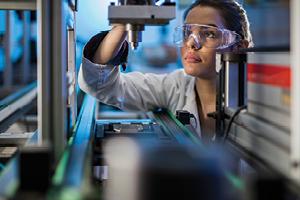How to find transitional duties for your injured workers
Many times employers, when faced with returning employees to work with temporary physical restrictions, find it difficult to identify tasks fitting into those limitations. Below are a few ideas on where to look for those tasks that may be approved by your employee's doctor and still add value to your business.
First, examine the job description of the employee.
- What tasks in that job description are outside of the restrictions provided by the doctor?
- Can those tasks be modified to fit the restrictions?
- Can an item being lifted be broken into lighter components?
- Can an employee sit versus standing if that is a restriction?
You need to understand the tasks of your employee and see if they can be changed.
- If they can't be changed, can tasks not meeting the restrictions be completed by another employee?
- Can the injured employee take on tasks in return from the healthy employee, tasks which are within the injured employee's restrictions?
Remember that bringing an employee back on transitional duty has other elements that will aid in controlling your costs, beyond the offset of the employee's pay to his/her disability payments. Breaking the habit of not reporting to work and being out of contact with management and fellow workers is a benefit. Maintaining communication with the employee, even if it means bringing the employee back part time until he/she is healed, has a positive outcome.
Second, when the job description cannot be modified, look at the tools and stock with which the employee works. Look at the skills the employee has or can be trained for.
- Are there other tasks that the injured worker can do to benefit your company?
- Can he/she maintain tools, order stock, or drive and deliver materials?
- Is there a service your business pays for that the injured worker can temporarily provide?
The goal, again, is to add value to your business. "Make work" tasks, such as counting paper clips, have been ruled as not meeting the intent of workers' compensation laws and are not allowed in many states. These types of strategies can lead to an adversarial relationship between employees and management and can lead to more expensive claims.
Third, are there projects that you never seem to get around to completing that fit the restrictions of the injured worker?
- Is there a storeroom that needs to be reorganized?
- Is there computer recordkeeping that needs to be caught up on?
- Is it time to take inventory?
- Is there any maintenance on your property such as painting that needs to be done?
When thinking of transitional duty, the goal is to reduce the impact of the claim while engaging your employee with your organization. Remember that sitting at home, your employee becomes deconditioned from going to work every day, becomes disconnected from you, and may believe that you have no concern for him/her. These can lead to difficulty returning him/her to work. The quicker the doctor can provide restrictions, and you can provide the opportunity to return to work at transitional duty, the better it will be for everyone.
This material is provided for informational purposes only and does not provide any coverage or guarantee loss prevention. The examples in this material are provided as hypothetical and for illustration purposes only. The Hanover Insurance Company and its affiliates and subsidiaries (“The Hanover”) specifically disclaim any warranty or representation that acceptance of any recommendations contained herein will make any premises, or operation safe or in compliance with any law or regulation. By providing this information to you. The Hanover does not assume (and specifically disclaims) any duty, undertaking or responsibility to you. The decision to accept or implement any recommendation(s) or advice contained in this material must be made by you.
LC OCT 2018 14-53
171-1089 (3/14)
Related resources
How to find transitional duties for your injured workers
Many times employers, when faced with returning employees to work with temporary physical restrictions, find it difficult to identify tasks fitting into those limitations. Below are a few ideas on where to look for those tasks that may be approved by your employee's doctor and still add value to your business.
First, examine the job description of the employee.
- What tasks in that job description are outside of the restrictions provided by the doctor?
- Can those tasks be modified to fit the restrictions?
- Can an item being lifted be broken into lighter components?
- Can an employee sit versus standing if that is a restriction?
You need to understand the tasks of your employee and see if they can be changed.
- If they can't be changed, can tasks not meeting the restrictions be completed by another employee?
- Can the injured employee take on tasks in return from the healthy employee, tasks which are within the injured employee's restrictions?
Remember that bringing an employee back on transitional duty has other elements that will aid in controlling your costs, beyond the offset of the employee's pay to his/her disability payments. Breaking the habit of not reporting to work and being out of contact with management and fellow workers is a benefit. Maintaining communication with the employee, even if it means bringing the employee back part time until he/she is healed, has a positive outcome.
Second, when the job description cannot be modified, look at the tools and stock with which the employee works. Look at the skills the employee has or can be trained for.
- Are there other tasks that the injured worker can do to benefit your company?
- Can he/she maintain tools, order stock, or drive and deliver materials?
- Is there a service your business pays for that the injured worker can temporarily provide?
The goal, again, is to add value to your business. "Make work" tasks, such as counting paper clips, have been ruled as not meeting the intent of workers' compensation laws and are not allowed in many states. These types of strategies can lead to an adversarial relationship between employees and management and can lead to more expensive claims.
Third, are there projects that you never seem to get around to completing that fit the restrictions of the injured worker?
- Is there a storeroom that needs to be reorganized?
- Is there computer recordkeeping that needs to be caught up on?
- Is it time to take inventory?
- Is there any maintenance on your property such as painting that needs to be done?
When thinking of transitional duty, the goal is to reduce the impact of the claim while engaging your employee with your organization. Remember that sitting at home, your employee becomes deconditioned from going to work every day, becomes disconnected from you, and may believe that you have no concern for him/her. These can lead to difficulty returning him/her to work. The quicker the doctor can provide restrictions, and you can provide the opportunity to return to work at transitional duty, the better it will be for everyone.
This material is provided for informational purposes only and does not provide any coverage or guarantee loss prevention. The examples in this material are provided as hypothetical and for illustration purposes only. The Hanover Insurance Company and its affiliates and subsidiaries (“The Hanover”) specifically disclaim any warranty or representation that acceptance of any recommendations contained herein will make any premises, or operation safe or in compliance with any law or regulation. By providing this information to you. The Hanover does not assume (and specifically disclaims) any duty, undertaking or responsibility to you. The decision to accept or implement any recommendation(s) or advice contained in this material must be made by you.
LC OCT 2018 14-53
171-1089 (3/14)
Related resources
How to find transitional duties for your injured workers
Many times employers, when faced with returning employees to work with temporary physical restrictions, find it difficult to identify tasks fitting into those limitations. Below are a few ideas on where to look for those tasks that may be approved by your employee's doctor and still add value to your business.
First, examine the job description of the employee.
- What tasks in that job description are outside of the restrictions provided by the doctor?
- Can those tasks be modified to fit the restrictions?
- Can an item being lifted be broken into lighter components?
- Can an employee sit versus standing if that is a restriction?
You need to understand the tasks of your employee and see if they can be changed.
- If they can't be changed, can tasks not meeting the restrictions be completed by another employee?
- Can the injured employee take on tasks in return from the healthy employee, tasks which are within the injured employee's restrictions?
Remember that bringing an employee back on transitional duty has other elements that will aid in controlling your costs, beyond the offset of the employee's pay to his/her disability payments. Breaking the habit of not reporting to work and being out of contact with management and fellow workers is a benefit. Maintaining communication with the employee, even if it means bringing the employee back part time until he/she is healed, has a positive outcome.
Second, when the job description cannot be modified, look at the tools and stock with which the employee works. Look at the skills the employee has or can be trained for.
- Are there other tasks that the injured worker can do to benefit your company?
- Can he/she maintain tools, order stock, or drive and deliver materials?
- Is there a service your business pays for that the injured worker can temporarily provide?
The goal, again, is to add value to your business. "Make work" tasks, such as counting paper clips, have been ruled as not meeting the intent of workers' compensation laws and are not allowed in many states. These types of strategies can lead to an adversarial relationship between employees and management and can lead to more expensive claims.
Third, are there projects that you never seem to get around to completing that fit the restrictions of the injured worker?
- Is there a storeroom that needs to be reorganized?
- Is there computer recordkeeping that needs to be caught up on?
- Is it time to take inventory?
- Is there any maintenance on your property such as painting that needs to be done?
When thinking of transitional duty, the goal is to reduce the impact of the claim while engaging your employee with your organization. Remember that sitting at home, your employee becomes deconditioned from going to work every day, becomes disconnected from you, and may believe that you have no concern for him/her. These can lead to difficulty returning him/her to work. The quicker the doctor can provide restrictions, and you can provide the opportunity to return to work at transitional duty, the better it will be for everyone.
This material is provided for informational purposes only and does not provide any coverage or guarantee loss prevention. The examples in this material are provided as hypothetical and for illustration purposes only. The Hanover Insurance Company and its affiliates and subsidiaries (“The Hanover”) specifically disclaim any warranty or representation that acceptance of any recommendations contained herein will make any premises, or operation safe or in compliance with any law or regulation. By providing this information to you. The Hanover does not assume (and specifically disclaims) any duty, undertaking or responsibility to you. The decision to accept or implement any recommendation(s) or advice contained in this material must be made by you.
LC OCT 2018 14-53
171-1089 (3/14)
Related resources
How to find transitional duties for your injured workers
Many times employers, when faced with returning employees to work with temporary physical restrictions, find it difficult to identify tasks fitting into those limitations. Below are a few ideas on where to look for those tasks that may be approved by your employee's doctor and still add value to your business.
First, examine the job description of the employee.
- What tasks in that job description are outside of the restrictions provided by the doctor?
- Can those tasks be modified to fit the restrictions?
- Can an item being lifted be broken into lighter components?
- Can an employee sit versus standing if that is a restriction?
You need to understand the tasks of your employee and see if they can be changed.
- If they can't be changed, can tasks not meeting the restrictions be completed by another employee?
- Can the injured employee take on tasks in return from the healthy employee, tasks which are within the injured employee's restrictions?
Remember that bringing an employee back on transitional duty has other elements that will aid in controlling your costs, beyond the offset of the employee's pay to his/her disability payments. Breaking the habit of not reporting to work and being out of contact with management and fellow workers is a benefit. Maintaining communication with the employee, even if it means bringing the employee back part time until he/she is healed, has a positive outcome.
Second, when the job description cannot be modified, look at the tools and stock with which the employee works. Look at the skills the employee has or can be trained for.
- Are there other tasks that the injured worker can do to benefit your company?
- Can he/she maintain tools, order stock, or drive and deliver materials?
- Is there a service your business pays for that the injured worker can temporarily provide?
The goal, again, is to add value to your business. "Make work" tasks, such as counting paper clips, have been ruled as not meeting the intent of workers' compensation laws and are not allowed in many states. These types of strategies can lead to an adversarial relationship between employees and management and can lead to more expensive claims.
Third, are there projects that you never seem to get around to completing that fit the restrictions of the injured worker?
- Is there a storeroom that needs to be reorganized?
- Is there computer recordkeeping that needs to be caught up on?
- Is it time to take inventory?
- Is there any maintenance on your property such as painting that needs to be done?
When thinking of transitional duty, the goal is to reduce the impact of the claim while engaging your employee with your organization. Remember that sitting at home, your employee becomes deconditioned from going to work every day, becomes disconnected from you, and may believe that you have no concern for him/her. These can lead to difficulty returning him/her to work. The quicker the doctor can provide restrictions, and you can provide the opportunity to return to work at transitional duty, the better it will be for everyone.
This material is provided for informational purposes only and does not provide any coverage or guarantee loss prevention. The examples in this material are provided as hypothetical and for illustration purposes only. The Hanover Insurance Company and its affiliates and subsidiaries (“The Hanover”) specifically disclaim any warranty or representation that acceptance of any recommendations contained herein will make any premises, or operation safe or in compliance with any law or regulation. By providing this information to you. The Hanover does not assume (and specifically disclaims) any duty, undertaking or responsibility to you. The decision to accept or implement any recommendation(s) or advice contained in this material must be made by you.
LC OCT 2018 14-53
171-1089 (3/14)





